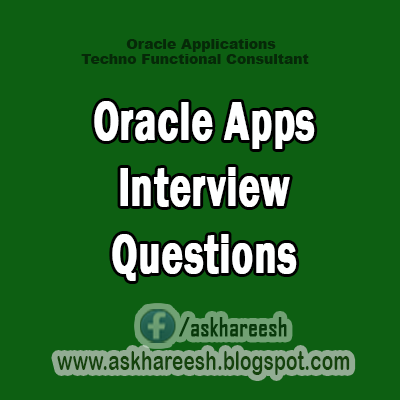
196) What is parameter in apps and from where u can create it?
Parameters only using in report, you can create in defining the report in
apps (you can create the parameter there only).
197)What all are the tables used in the modules u have worked on?
*In GL – I have worked on GL_JE_HEADERS(JOURNALS HEADER),GL_JE_LINES(JOURNAL LINES), GL_JE_BACHES(JOURNAL BATCHES), GL_SET_OF_BOOK(SET_OF_BOOK_ID),
*In PO- I have worked on PO_HEADER_ALL…..
198)What is Profile? Explain different levels of Profile?
A user profile is a set of changeable options that affects the way your applications run. Oracle Application Object Library establishes a value for each option in a user‟s profile when the user logs on or changes responsibility. Your user can change the value of profile options at any time a) To create Profile Option. ( Profile Option can created by developer in application developer area) b)set the value (Values of the profile option , who will have what value at various levels is set by SYSADMIN). Oracle Application Object Library provides many options that. (Edit profile feature for every user is available to set any value to allow the user).your users can set to alter the user interface of your applications to satisfy their individual preferences. Profile Option – set at run time like – User Related, responsibility, Sequence, Printer, Security.
61 Values in 4 Levels(HIEARCHY WISE) :-
- USER
- RESPONSIBILITY
- APPLICATION
- SITE
( Usage in the multi-tier, the profile is biggest impact)
199)How to restrict the data for a responsibility as per the ORG-ID?
Through Multi – Org(MO) u can restrict the data for a responsibility as per the ORG-ID. Only in GL- Set of book Id you set the value to restrict the data for a responsibility.
200) is Flexfield? What is flexfield qualifier and what is segment qualifier?
A flexfield is made up a segments (Which are actually table columns). Each segment has a name that can be assigned, and set of valid value.
Purpose and Application:-
- Flexibility to implement code structure.
- Flexibility to capture additional information.
- Key Flexfields (KFF)
- Descriptive Flexfields (DFF)
Flexfield Qualifier:-A flexfield qualifier identifies a particular segment of a key flexfield.. Usually an application needs some method of identifying a particular
segment for some application purpose such as security or computations. However, since a key flexfield can be customized so that segments appear in any order with any prompts, the application needs a mechanism other than the segment name or segment order to
use for segment identification.
Segment Qualifier :- A segment qualifier identifies a particular type of value in a single segment of a key flexfield.
In the Oracle Applications, only the. Accounting Flexfield uses segment qualifiers. You can think of a segment qualifier as an "identification tag" for a value. In the Accounting Flexfield, segment qualifiers can identify the account type.
201)Which flexfield qualifiers are mandatory?
"Balancing Segment‟ flex field qualifier is mandatory.
202)Difference Between versions of Apps.(Front end & Database)?
In backend- Client server architecture (old)/ Three tire architecture
In font end- Client Server Application (old)/ Web Based application
203)What is MULTI-ORG and what is structure of multi-org?
Use a single installation of any oracle applications product to support any number of organizations. if those organizations use different set of books.
Support any number or legal entities with a single installation of oracle applications. 62 Secure access to data so that users can access only the information that is relevant to them. Structure :- Business Unit -HRMS(Employee)
-GL(Set of Books)(Currency, Calendar, Chart of Account)
Balancing Segment(You can do multiple balancing segment)
-Operating Units (Purchase, Selling, Fixed Asset, Payable,Receivables)
-Inventory Organizations (Storing Items, Transaction Happening,Ware Housing)
(Note:- Means if you maintaining GL(set of book id), If u have operating unit, if you
have inventory then its called MULTI-ORG)
204)What is difference between ORG_ID and ORGANIZATION_ID in Multi-Org.
At where we can set ORG_ID and ORGANIZATION_ID level it comes in the
structure?
A Global Variable exists in the oracle database called CLIENT_INFO, which is 64 bytes long. The first 10 bytes are used to store the operating unit ID(or ORG_ID) for the multiple organization support feature.
Multi-Org views are partitioned by ORG_ID. The ORG_ID value is stored in CLIENT_INFO variable.(It comes in AP,PO,AR,OM level)
ORGANIZATION_ID – Its for Inventory, Mfg, & BOM.
205)ORG_ID can be set at master levels or transaction level?
ORG_ID can be set at transaction Level.
206) Differnet type of execution methods in Conc.Progs. Explain Each Type?
Oracle Reports- You can register your report as executable file type is oracle reports.
PL/SQL Package Procedure - You can register your PL/SQL Package Procedure as executable file type is oracle PL/SQL Package Procedure.
SQL Loader- You can register your SQL Loader SQL Loader is your executable file type.(for data loading)
SQL*Plus :- You can register your SQL script as SQL*Plus executable type.
Host Scripting:- You can write down Unix Host scripting and register here.
207)What is difference between oracle schema and apps schema?
The APPS schema- is an ORACLE schema that has access to the
complete Oracle Applications data model. This schema is maintained
by AutoInstall.
208) What are the objects APPS schema contain?
The APPS schema contains synonyms to all tables and
sequences as well as all server–side code (stored procedures, views,and database triggers).For ERP applications, data partitioning is performed by database
views. These views reside in the APPS Oracle schema and derive the 63 appropriate operating unit context from an RDBMS variable.
209)What are the names of the parameters u pass to the Procedure which u register in the apps?
- retcode in varchar2
- errbuf in varchar2
210) What is application short name for General Ledger you specify in FND FLEXSQL user exit?
SQLGL

No comments:
Post a Comment